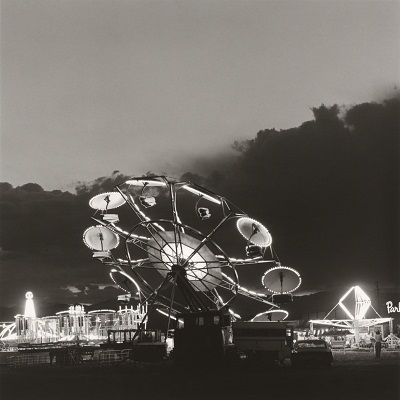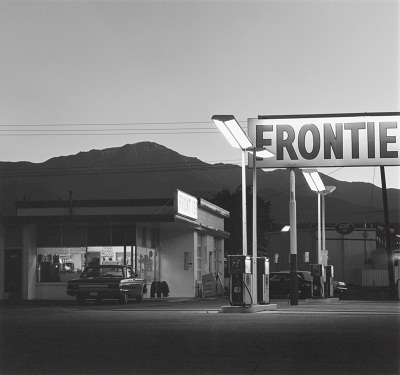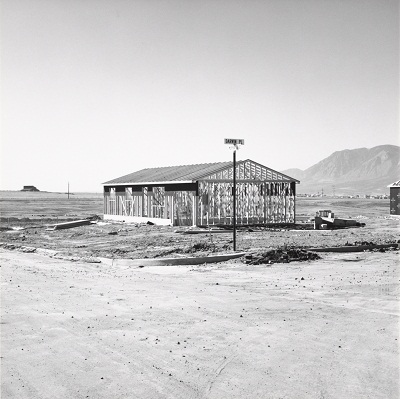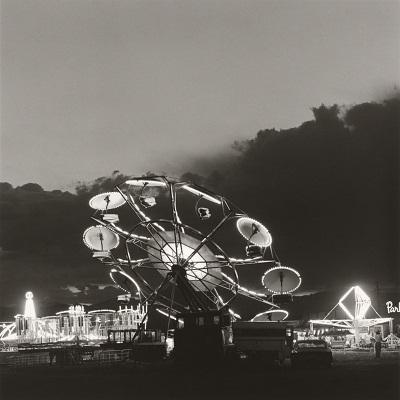When I first saw the photos in the retrospective Robert Adams: The Place We Live, in particular, Longmont, Colorado (1979), which is a black-and-white photo that depicts the Boulder County Fairgrounds at night, I felt an uncomfortable sense of pride and a strange sense of resilience. My memories of the Boulder County Fair burn bright. I won innumerable goldfish there, stuffed myself with countless reams of cotton candy, and chickened out of riding nearly every single ride.
Adams’s photo out of context is stunning. One lit-up ride rises up into blackened clouds like an electrified jellyfish in the darkest depths of the ocean. Lights of other rides set the bottom half of the photograph ablaze. In the background, you can make out the faint silhouette of the foothills of the Rocky Mountains—a majestic backdrop that is omnipresent in my childhood memories.

Robert Adams, Longmont, Colorado, 1979, Yale University Art Gallery, purchased with a gift from Saundra B. Lane, a grant from Trellis Fund, and the Janet and Simeon Braguin Fund
As a child, I believed that there were only two notable landmarks in my hometown: the turkey factory and the Boulder County Fairgrounds. The turkey factory, called Longmont Foods at the time, was located, appropriately, on Main Street of Longmont, Colorado, just a couple of miles down the road from the farming equipment company that my father owned (and still does). Railroad tracks lined the south side of the factory; its cars thundered by three to four times a day, causing the closest thing to a traffic jam my town will ever see. At certain times in the morning and the evening, the turkey factory produced the unmistakable—and nauseating—scent of death and not-right hotdogs, which blanketed the area within a half-mile radius for a good hour or so. Tractor trailers mounted with cage after cage of plump, protesting turkeys shed clouds of white feathers through town as they made their way to slaughter.
Just across the street from the factory was a tiny building that must have, once upon a time, acted as a real-life train depot. During my childhood, however, it was a Domino’s Pizza, a bail bond agent, a real estate company, a bodega, a Mexican restaurant . . . What it is now—if anything—I have no idea. Nothing ever stayed there—nothing ever could. The conditions were that unbearable.
In fact, as a teenager, this was a perfect metaphor for my feelings about my hometown. Longmont was the turkey factory, and I was the little train depot grasping desperately for an identity that allowed me to survive in that place.

Robert Adams, Pikes Peak, Colorado Springs, Colorado, 1969, Yale University Art Gallery, purchased with a gift from Saundra B. Lane, a grant from Trellis Fund, and the Janet and Simeon Braguin Fund
Though I feel a personal connection to some of Adams’s photos because I grew up in a region that he photographed, I don’t think you have to be from the area to derive the stark tension—even the irony—inherent in his subjects as he pits man against nature time and again. For instance, in the photo above, the gas station sign in the foreground marks the “frontier” of technology, of man’s impingement on the actual, natural frontier in the background. Likewise, in Frame for a Tract House, Colorado Springs, Colorado, a lone street sign, “Darwin Pl,” ironically, and I think cruelly, marks the place of the skeleton of a cookie-cutter-house-in-the-making, as the mountains dissolve into the background.

Robert Adams, Frame for a Tract House, Colorado Springs, Colorado, 1969, Yale University Art Gallery, purchased with a gift from Saundra B. Lane, a grant from Trellis Fund, and the Janet and Simeon Braguin Fund
Though I don’t often return to my hometown, the place I once lived is always with me and most likely always will be.
Jenny Miyasaki



